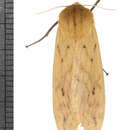If you live in North America, chances are good that you’ve come across the banded woolly bear caterpillar, a fuzzy caterpillar black on either end and red in the middle. However, you might not have associated it with its adult moth form, an unimpressive small yellow-orange moth with a fuzzy body, which is known by a different common name, the Isabella tiger moth.
Pyrrharctia isabella has a widespread distribution, mainly in open parkland and prairie habitats across North America, and this species has much folk lore surrounding it. For example, the size of the caterpillar’s red band is said to predict the severity of the upcoming winter (in actuality, the the age and instar of the caterpillar determines the band size). There are several annual festivals dedicated to celebrating the woolly bear (e.g. in Vermilion, Ohio, Banner Elk, NC, Beattyville, Kentucky, and Lewisburg, PA).
Pyrrharctia isabella generally undergoes two generations a year, the second of which hatches from eggs into caterpillars in the fall, which then go dormant under leaf litter to overwinter cold climates. To prevent damage occurring to their tissues in freezing climates, they produce a cryoprotectant in their hemolymph (circulatory fluid). Over the summer, caterpillars grow to full size, eating a wide diversity of host plants including: asters, birch leaves, clover, corn, dandelions, elm leaves, maple leaves, sunflowers, and nettles. If disturbed, caterpillars will curl up and lie still, as if dead. Despite common belief, the stiff hairs (setae) that cover their bodies do not irritate the skin if they are picked up.
(Layne et al 1999; Layne and Kuharsky 2000;
Wikipedia 2011)

